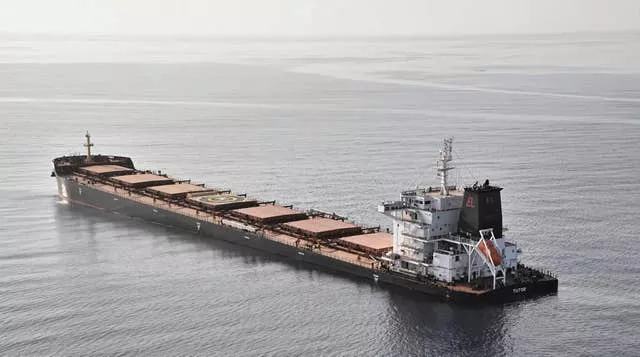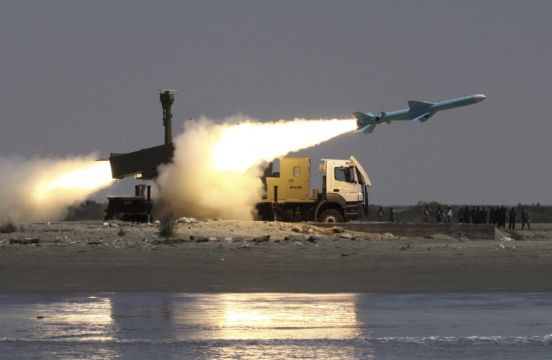Yemen’s Houthi rebels likely fired an Iranian-made anti-ship cruise missile at a Norwegian-flagged tanker in the Red Sea in December, an assault that now provides a public evidence-based link between the ongoing rebel campaign against shipping and Tehran, the US military says.
A report by the US Defence Intelligence Agency (DIA) released on Wednesday linked the attack on the Strinda, which set the vessel ablaze, to Tehran, the Houthi’s main backer in Yemen’s nearly decade-long war.
The findings correspond with those of a Norway-based insurers group that also examined debris found on the Strinda.
It comes as the Houthis continue their months-long campaign of attacks over the Israel-Hamas war, targeting ships in the Red Sea corridor, disrupting the flow of goods passing through it annually while also sparking the most intense combat the US Navy has seen since the Second World War.
Iran’s mission to the United Nations did not immediately respond to a request for comment.
The Strinda was coming from Malaysia and was bound for the Suez Canal and then on to Italy with a cargo of palm oil when it was struck by a missile on December 11.
The attack sparked a major fire on board that the crew extinguished without anyone being hurt.
Debris found on board later was analysed by the US military. The DIA compared the pieces of the engine from the missile found on board to the Iranian Noor anti-ship ballistic cruise missile.
“The Iranian Tolu-4 turbojet engine, used in the Noor (missile), has unique features — including the compressor stage and stator — that are consistent with engine debris recovered from the … Houthi attack on the M/T Strinda,” the DIA report said. A stator is the stationary portion of an engine.
Those pieces match images of a Tolu-4 engine that Iran displayed at the International Air and Space Show in Russia in 2017, the DIA said. Visually, the engines bore similarities to the photographs.

The Noor was reverse-engineered by Iran from the Chinese C-802 anti-ship missile, which Iran purchased from Beijing and began testing in 1996.
The Norwegian Shipowners’ Mutual War Risks Insurance Association, known by the acronym DNK, also examined the debris following the Strinda attack. The association assessed it was “highly likely” the vessel had been hit by a C-802 or Noor anti-ship cruise missile.
Before the Houthis swept into Yemen’s capital, Sanaa, in 2014, the country did not have an arsenal of C-802 missiles.
As the Saudi-led coalition entered Yemen’s conflict on behalf of its exiled government in 2015, the Houthis’ arsenal was increasingly targeted. Soon — and despite Yemen having no indigenous missile manufacturing infrastructure — newer missiles made their way into rebel hands.
Iran has long denied arming the Houthis, likely because of a years-long United Nations arms embargo on the rebels. However, the US and its allies have seized multiple arms shipments bound for the rebels in Mid-East waters.
Weapons experts have also tied Houthi arms seized on the battlefield back to Iran.
The Houthis have launched seaborne attacks since 2016 when they hit the Emirati vessel SWIFT-1 with a missile as it sailed back and forth in the Red Sea between an Emirati troop base in Eritrea and Yemen.
They also tried to attack the USS Mason, an Arleigh Burke-class guided-missile destroyer, around the same time.
But the Houthi attacks have rapidly escalated since November over the Israel-Hamas war in the Gaza Strip. The rebels have targeted more than 70 vessels by firing missiles and drones in their campaign, which has killed four sailors.
They have seized one vessel and sank two in the time since.
The Houthis maintain that their attacks target ships linked to Israel, the United States or Britain as part of the rebels’ support for the militant group Hamas in its war against Israel.
However, many of the ships attacked have little or no connection to the war — including some bound for Iran, which backs the Houthis.
“The Houthis probably have used Iran-supplied weapons to conduct more than 100 attacks against land-based targets in Israel, Saudi Arabia, the United Arab Emirates, and Yemen and dozens of attacks targeting ships in the Red Sea and Gulf of Aden,” the DIA report said.







